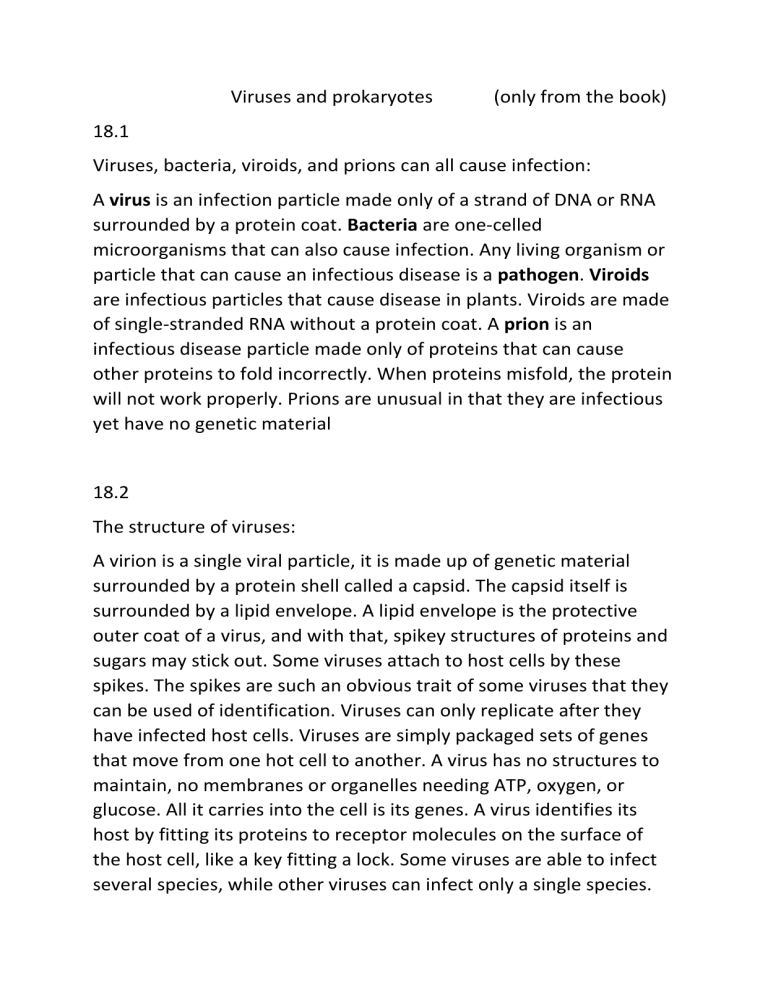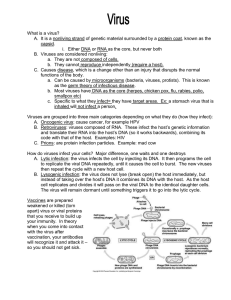
Viruses and prokaryotes (only from the book) 18.1 Viruses, bacteria, viroids, and prions can all cause infection: A virus is an infection particle made only of a strand of DNA or RNA surrounded by a protein coat. Bacteria are one-celled microorganisms that can also cause infection. Any living organism or particle that can cause an infectious disease is a pathogen. Viroids are infectious particles that cause disease in plants. Viroids are made of single-stranded RNA without a protein coat. A prion is an infectious disease particle made only of proteins that can cause other proteins to fold incorrectly. When proteins misfold, the protein will not work properly. Prions are unusual in that they are infectious yet have no genetic material 18.2 The structure of viruses: A virion is a single viral particle, it is made up of genetic material surrounded by a protein shell called a capsid. The capsid itself is surrounded by a lipid envelope. A lipid envelope is the protective outer coat of a virus, and with that, spikey structures of proteins and sugars may stick out. Some viruses attach to host cells by these spikes. The spikes are such an obvious trait of some viruses that they can be used of identification. Viruses can only replicate after they have infected host cells. Viruses are simply packaged sets of genes that move from one hot cell to another. A virus has no structures to maintain, no membranes or organelles needing ATP, oxygen, or glucose. All it carries into the cell is its genes. A virus identifies its host by fitting its proteins to receptor molecules on the surface of the host cell, like a key fitting a lock. Some viruses are able to infect several species, while other viruses can infect only a single species. Viruses often have capsids shaped in coils. A virus can have either DNA or RNA, but never both. The genetic material of viruses can be single-stranded or double-stranded, and linear, circular, or segmented. Viruses that infect bacteria: Bacteriophages are a group of viruses that infect bacteria; one example is the T-bacteriophage that infects the bacteria commonly found in the intestines of mammals. Viruses that infect Eukaryotes: Viruses that infect Eukaryotes differ from bacteriophages in their methods of entering the host cell; example, these viruses may enter the cells by endocytosis. Endocytosis is an active method of brining molecules into a cell by forming vesicles, or membrane-bound sacs, around the molecules. If the viruses are enveloped, they can also enter a host cell by fusing with the plasma membrane of the host cell and releasing the capsid into the cell’s cytoplasm. Viruses can cause 2 types of infection: 2 basic pathways of infection are similar for all viruses. Once inside the host cell, phages follow one of 2 general paths in causing disease. Lytic infection: A lytic infection is an infection pathway in which the host cell bursts, releasing the new viral offspring into the host’s system, where each then infects another cell. When the viral DNA enters the host cell, it takes over control of the host’s own DNA. The host’s DNA undergoes transcription and translation and produces capsids and enzymes. The enzymes then help in the copyi8ng of the virus’s DNA. Viral enzymes dissolve the host cell membrane, releasing the new virus particles into the host’s bloodstream or tissues, and destroying the host cell in the process. Lysogenic infection: In a Lysogenic infection, a phage combines its DNA into the host cell’s DNA. After entering the host cell, the viral DNA combines with the host’s DNA, forming a new set of genes called a prophage. A prophage is the phage DNA inserted into the host cell’s DNA. The prophage is copied and passed to daughter cells, with the host’s own DNA, when the host cell undergoes mitosis. After the cell has been copied, the prophage faces 2 possible paths. A trigger, such as stress, can activate the prophage, which then uses the cell to produce new viruses. Or the prophage can remain as permanent gene. 18.3 First defences: In vertebrates, the first obstacle a virus must pass is the skin, but in other organisms it might be an outer skeleton or tough cell wall. Viruses can penetrate the skin only through an opening such as a cut or scrape. The mucous membranes and body openings. Once inside the body, the virus finds its way to its target organ or tissue. Body cells have receptors that guard against foreign intruders. When the virus arrives at the host cell, it uses its own surface proteins as keys to trick the cell into allowing it to enter. Examples of viral infections: The common cold: The most familiar viral disease is the common cold. More than 200 viruses can mutate as they move from one person to another. Influenza: The flu spreads quickly and can result in frequent local epidemics. An epidemic is a rapid outbreak of an infection that affects many people. Sometimes, a mutation enables a virus to jump from one species to another making the spread of infection difficult to control. A vaccine is a substance that stimulates the body’s own immune response against invasion by microbes. SARS, (severe acute respiratory syndrome): It’s another viral respiratory disease, its symptoms are fever, and coughing, or difficulty in breathing. HIV (Human immunodeficiency virus): It’s a retrovirus. Usually, DNA is used to make an RNA copy in a cell, but a retrovirus is a virus that contains RNA and uses an enzyme called reverse transcriptase to make a DNA copy. Double stranded DNA then enters the nucleus and combines with the host genes as a lysogenic infection. The ne virus leave, either by budding or bursting through cell membranes, and infect new cells. This stage of the disease is a lytic infection that destroys white blood cells of the host’s immune system. The loss of white blood cells ultimately causes AIDS (Acquired immune deficiency syndrome). Once a person’s immune system is affected, or she may be unable to fight off even the common microorganisms that humans encounter every day. Vaccines are made from weakened pathogens: A vaccine is made from the same pathogen, that it is supposed to protect against. Vaccines consist of weakened versions of the virus, or parts of the virus, that will cause the body to produce a response. In the host’s body, the vaccine works by preparing the host’s immune system for a future attack. Vaccines can prevent some bacterial and some viral infections.




